Risk Assessment Report on Trading.com
VerifiedAdded on 2023/03/21
|11
|2857
|78
AI Summary
This report is a risk assessment of Trading.com, a company offering stock trading services. It identifies and ranks various risks faced by the company, such as performance pressure, expansion rate, and inexperience of employees. The report also provides recommendations to manage these risks.
Contribute Materials
Your contribution can guide someone’s learning journey. Share your
documents today.

Governance, Ethics and Sustainability
Secure Best Marks with AI Grader
Need help grading? Try our AI Grader for instant feedback on your assignments.
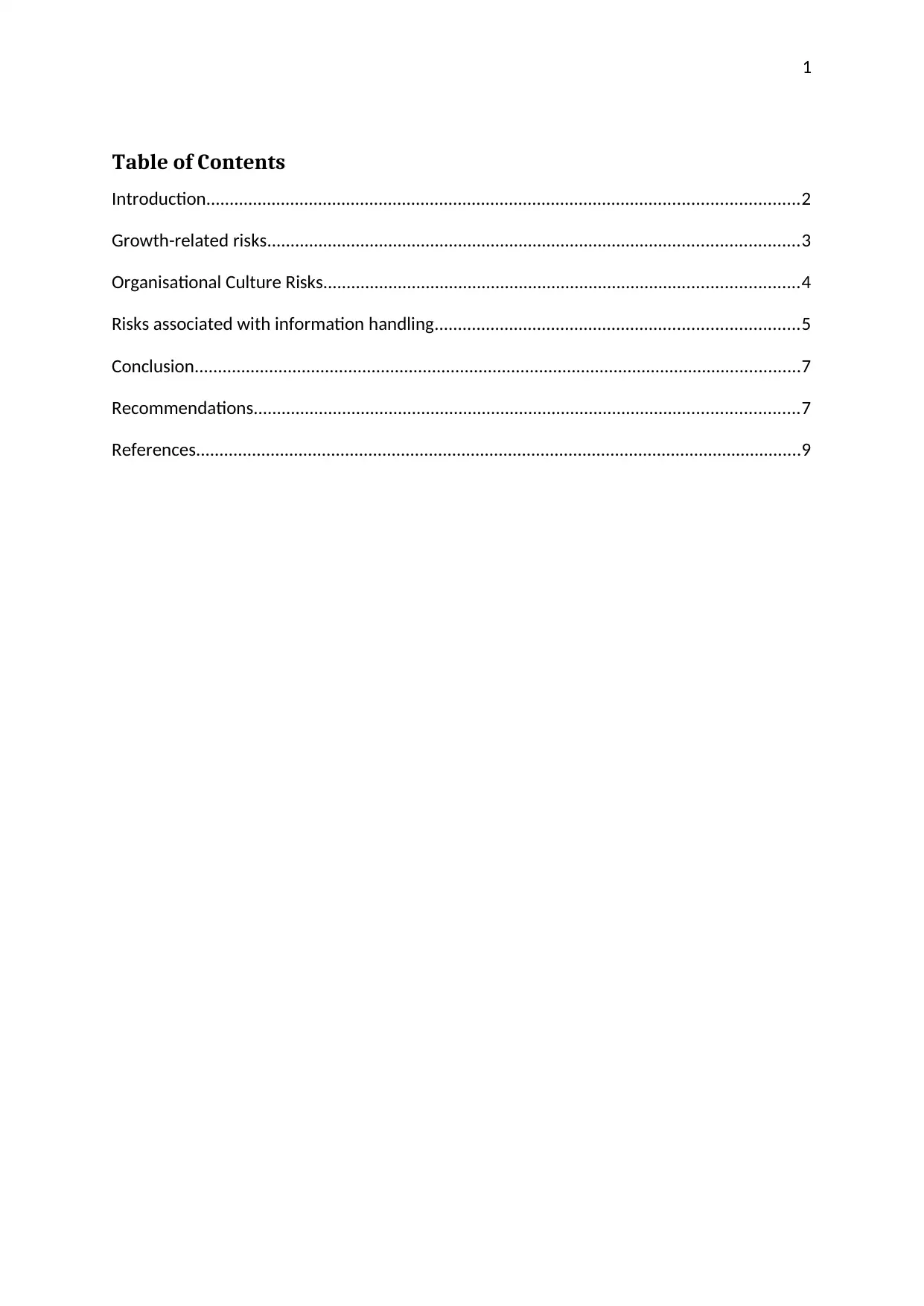
1
Table of Contents
Introduction...............................................................................................................................2
Growth-related risks..................................................................................................................3
Organisational Culture Risks......................................................................................................4
Risks associated with information handling..............................................................................5
Conclusion..................................................................................................................................7
Recommendations.....................................................................................................................7
References..................................................................................................................................9
Table of Contents
Introduction...............................................................................................................................2
Growth-related risks..................................................................................................................3
Organisational Culture Risks......................................................................................................4
Risks associated with information handling..............................................................................5
Conclusion..................................................................................................................................7
Recommendations.....................................................................................................................7
References..................................................................................................................................9
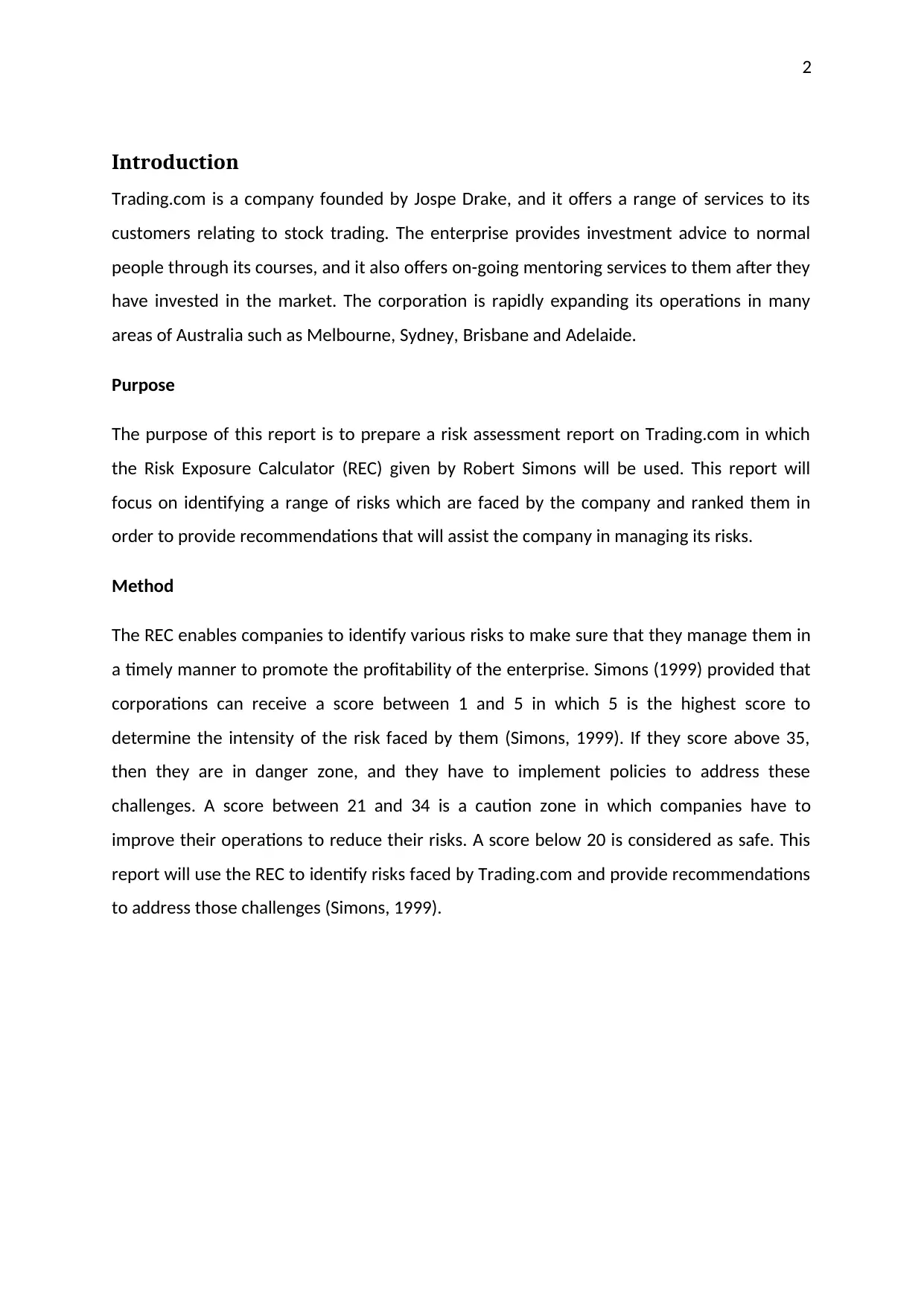
2
Introduction
Trading.com is a company founded by Jospe Drake, and it offers a range of services to its
customers relating to stock trading. The enterprise provides investment advice to normal
people through its courses, and it also offers on-going mentoring services to them after they
have invested in the market. The corporation is rapidly expanding its operations in many
areas of Australia such as Melbourne, Sydney, Brisbane and Adelaide.
Purpose
The purpose of this report is to prepare a risk assessment report on Trading.com in which
the Risk Exposure Calculator (REC) given by Robert Simons will be used. This report will
focus on identifying a range of risks which are faced by the company and ranked them in
order to provide recommendations that will assist the company in managing its risks.
Method
The REC enables companies to identify various risks to make sure that they manage them in
a timely manner to promote the profitability of the enterprise. Simons (1999) provided that
corporations can receive a score between 1 and 5 in which 5 is the highest score to
determine the intensity of the risk faced by them (Simons, 1999). If they score above 35,
then they are in danger zone, and they have to implement policies to address these
challenges. A score between 21 and 34 is a caution zone in which companies have to
improve their operations to reduce their risks. A score below 20 is considered as safe. This
report will use the REC to identify risks faced by Trading.com and provide recommendations
to address those challenges (Simons, 1999).
Introduction
Trading.com is a company founded by Jospe Drake, and it offers a range of services to its
customers relating to stock trading. The enterprise provides investment advice to normal
people through its courses, and it also offers on-going mentoring services to them after they
have invested in the market. The corporation is rapidly expanding its operations in many
areas of Australia such as Melbourne, Sydney, Brisbane and Adelaide.
Purpose
The purpose of this report is to prepare a risk assessment report on Trading.com in which
the Risk Exposure Calculator (REC) given by Robert Simons will be used. This report will
focus on identifying a range of risks which are faced by the company and ranked them in
order to provide recommendations that will assist the company in managing its risks.
Method
The REC enables companies to identify various risks to make sure that they manage them in
a timely manner to promote the profitability of the enterprise. Simons (1999) provided that
corporations can receive a score between 1 and 5 in which 5 is the highest score to
determine the intensity of the risk faced by them (Simons, 1999). If they score above 35,
then they are in danger zone, and they have to implement policies to address these
challenges. A score between 21 and 34 is a caution zone in which companies have to
improve their operations to reduce their risks. A score below 20 is considered as safe. This
report will use the REC to identify risks faced by Trading.com and provide recommendations
to address those challenges (Simons, 1999).
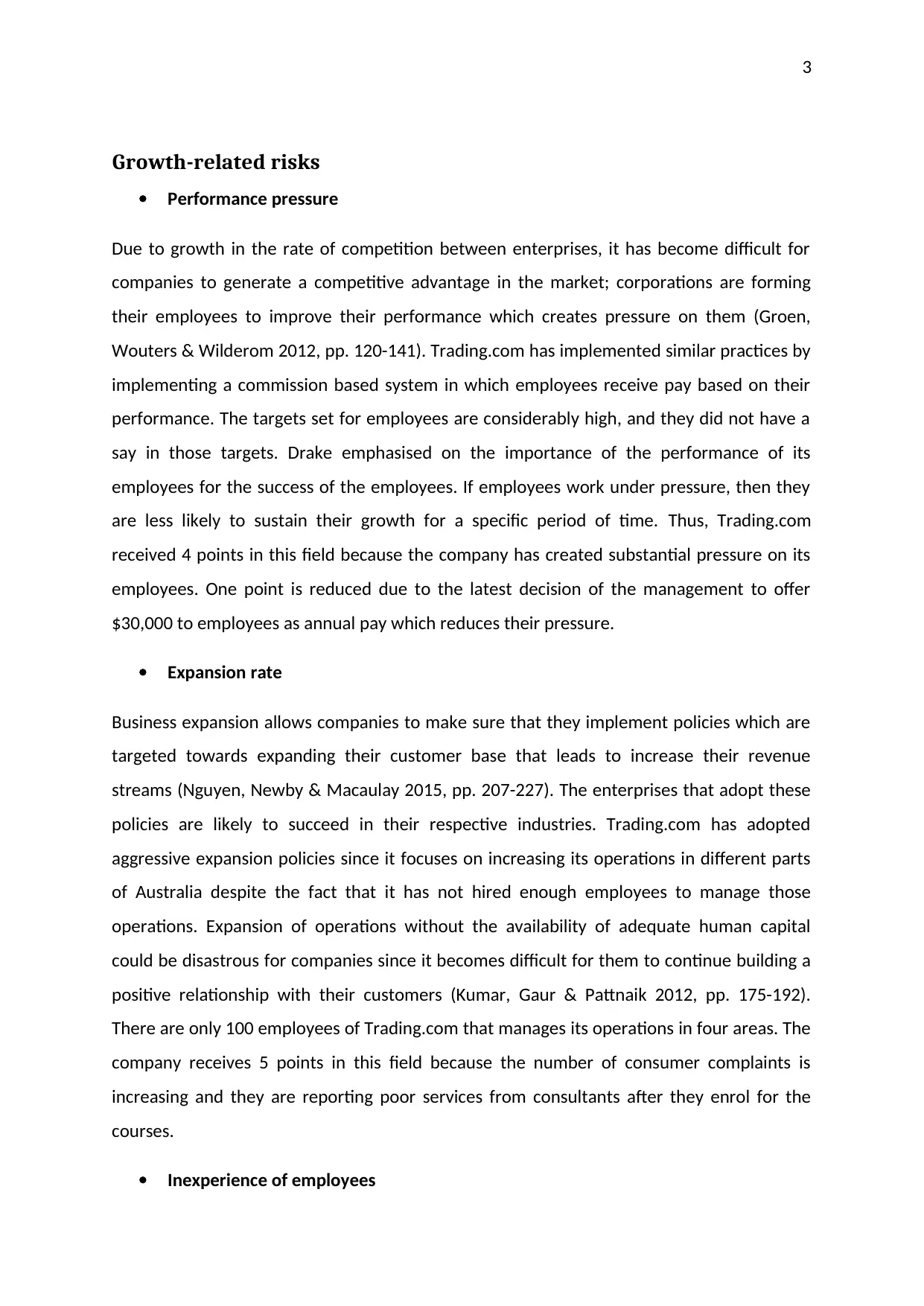
3
Growth-related risks
Performance pressure
Due to growth in the rate of competition between enterprises, it has become difficult for
companies to generate a competitive advantage in the market; corporations are forming
their employees to improve their performance which creates pressure on them (Groen,
Wouters & Wilderom 2012, pp. 120-141). Trading.com has implemented similar practices by
implementing a commission based system in which employees receive pay based on their
performance. The targets set for employees are considerably high, and they did not have a
say in those targets. Drake emphasised on the importance of the performance of its
employees for the success of the employees. If employees work under pressure, then they
are less likely to sustain their growth for a specific period of time. Thus, Trading.com
received 4 points in this field because the company has created substantial pressure on its
employees. One point is reduced due to the latest decision of the management to offer
$30,000 to employees as annual pay which reduces their pressure.
Expansion rate
Business expansion allows companies to make sure that they implement policies which are
targeted towards expanding their customer base that leads to increase their revenue
streams (Nguyen, Newby & Macaulay 2015, pp. 207-227). The enterprises that adopt these
policies are likely to succeed in their respective industries. Trading.com has adopted
aggressive expansion policies since it focuses on increasing its operations in different parts
of Australia despite the fact that it has not hired enough employees to manage those
operations. Expansion of operations without the availability of adequate human capital
could be disastrous for companies since it becomes difficult for them to continue building a
positive relationship with their customers (Kumar, Gaur & Pattnaik 2012, pp. 175-192).
There are only 100 employees of Trading.com that manages its operations in four areas. The
company receives 5 points in this field because the number of consumer complaints is
increasing and they are reporting poor services from consultants after they enrol for the
courses.
Inexperience of employees
Growth-related risks
Performance pressure
Due to growth in the rate of competition between enterprises, it has become difficult for
companies to generate a competitive advantage in the market; corporations are forming
their employees to improve their performance which creates pressure on them (Groen,
Wouters & Wilderom 2012, pp. 120-141). Trading.com has implemented similar practices by
implementing a commission based system in which employees receive pay based on their
performance. The targets set for employees are considerably high, and they did not have a
say in those targets. Drake emphasised on the importance of the performance of its
employees for the success of the employees. If employees work under pressure, then they
are less likely to sustain their growth for a specific period of time. Thus, Trading.com
received 4 points in this field because the company has created substantial pressure on its
employees. One point is reduced due to the latest decision of the management to offer
$30,000 to employees as annual pay which reduces their pressure.
Expansion rate
Business expansion allows companies to make sure that they implement policies which are
targeted towards expanding their customer base that leads to increase their revenue
streams (Nguyen, Newby & Macaulay 2015, pp. 207-227). The enterprises that adopt these
policies are likely to succeed in their respective industries. Trading.com has adopted
aggressive expansion policies since it focuses on increasing its operations in different parts
of Australia despite the fact that it has not hired enough employees to manage those
operations. Expansion of operations without the availability of adequate human capital
could be disastrous for companies since it becomes difficult for them to continue building a
positive relationship with their customers (Kumar, Gaur & Pattnaik 2012, pp. 175-192).
There are only 100 employees of Trading.com that manages its operations in four areas. The
company receives 5 points in this field because the number of consumer complaints is
increasing and they are reporting poor services from consultants after they enrol for the
courses.
Inexperience of employees
Secure Best Marks with AI Grader
Need help grading? Try our AI Grader for instant feedback on your assignments.
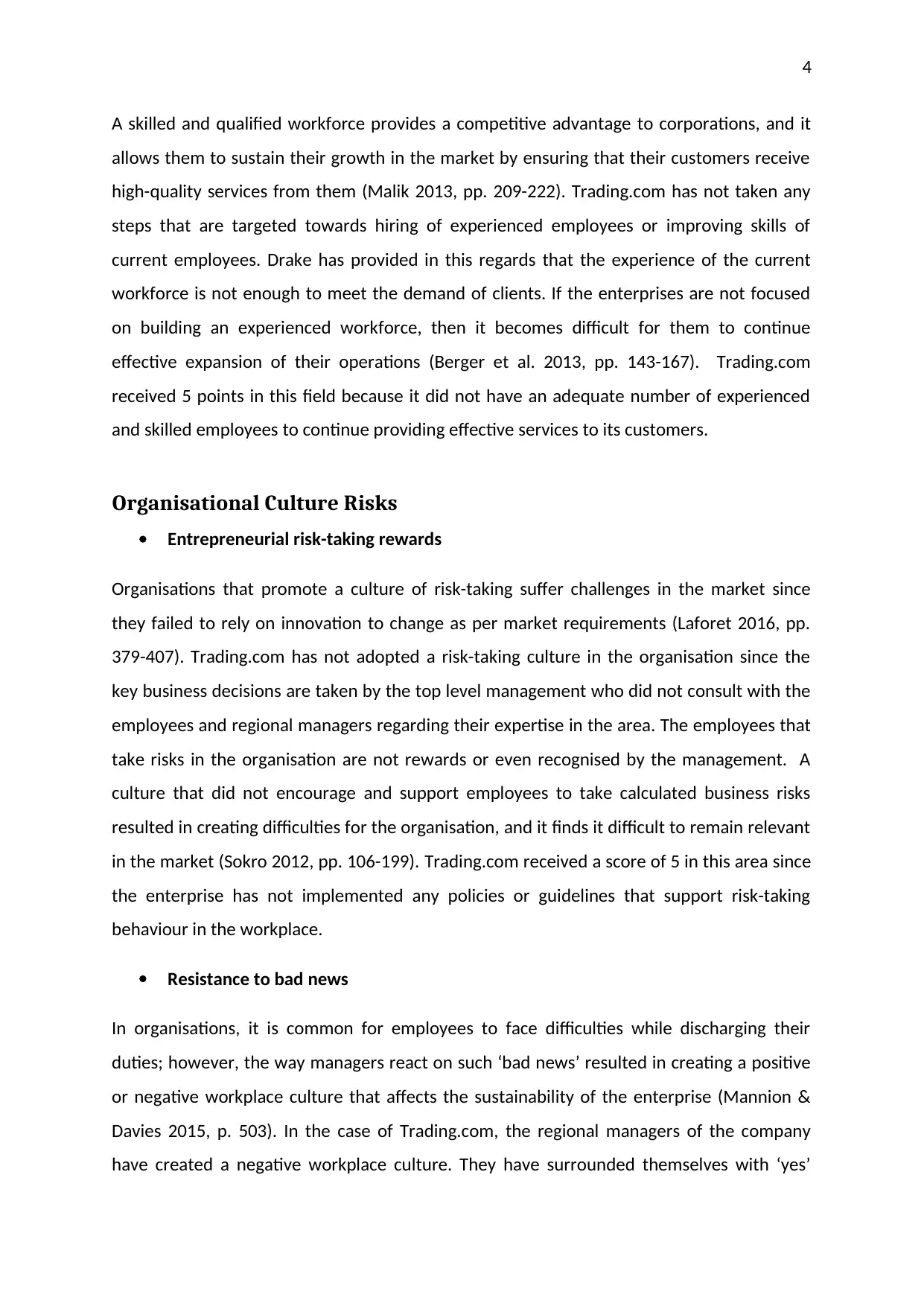
4
A skilled and qualified workforce provides a competitive advantage to corporations, and it
allows them to sustain their growth in the market by ensuring that their customers receive
high-quality services from them (Malik 2013, pp. 209-222). Trading.com has not taken any
steps that are targeted towards hiring of experienced employees or improving skills of
current employees. Drake has provided in this regards that the experience of the current
workforce is not enough to meet the demand of clients. If the enterprises are not focused
on building an experienced workforce, then it becomes difficult for them to continue
effective expansion of their operations (Berger et al. 2013, pp. 143-167). Trading.com
received 5 points in this field because it did not have an adequate number of experienced
and skilled employees to continue providing effective services to its customers.
Organisational Culture Risks
Entrepreneurial risk-taking rewards
Organisations that promote a culture of risk-taking suffer challenges in the market since
they failed to rely on innovation to change as per market requirements (Laforet 2016, pp.
379-407). Trading.com has not adopted a risk-taking culture in the organisation since the
key business decisions are taken by the top level management who did not consult with the
employees and regional managers regarding their expertise in the area. The employees that
take risks in the organisation are not rewards or even recognised by the management. A
culture that did not encourage and support employees to take calculated business risks
resulted in creating difficulties for the organisation, and it finds it difficult to remain relevant
in the market (Sokro 2012, pp. 106-199). Trading.com received a score of 5 in this area since
the enterprise has not implemented any policies or guidelines that support risk-taking
behaviour in the workplace.
Resistance to bad news
In organisations, it is common for employees to face difficulties while discharging their
duties; however, the way managers react on such ‘bad news’ resulted in creating a positive
or negative workplace culture that affects the sustainability of the enterprise (Mannion &
Davies 2015, p. 503). In the case of Trading.com, the regional managers of the company
have created a negative workplace culture. They have surrounded themselves with ‘yes’
A skilled and qualified workforce provides a competitive advantage to corporations, and it
allows them to sustain their growth in the market by ensuring that their customers receive
high-quality services from them (Malik 2013, pp. 209-222). Trading.com has not taken any
steps that are targeted towards hiring of experienced employees or improving skills of
current employees. Drake has provided in this regards that the experience of the current
workforce is not enough to meet the demand of clients. If the enterprises are not focused
on building an experienced workforce, then it becomes difficult for them to continue
effective expansion of their operations (Berger et al. 2013, pp. 143-167). Trading.com
received 5 points in this field because it did not have an adequate number of experienced
and skilled employees to continue providing effective services to its customers.
Organisational Culture Risks
Entrepreneurial risk-taking rewards
Organisations that promote a culture of risk-taking suffer challenges in the market since
they failed to rely on innovation to change as per market requirements (Laforet 2016, pp.
379-407). Trading.com has not adopted a risk-taking culture in the organisation since the
key business decisions are taken by the top level management who did not consult with the
employees and regional managers regarding their expertise in the area. The employees that
take risks in the organisation are not rewards or even recognised by the management. A
culture that did not encourage and support employees to take calculated business risks
resulted in creating difficulties for the organisation, and it finds it difficult to remain relevant
in the market (Sokro 2012, pp. 106-199). Trading.com received a score of 5 in this area since
the enterprise has not implemented any policies or guidelines that support risk-taking
behaviour in the workplace.
Resistance to bad news
In organisations, it is common for employees to face difficulties while discharging their
duties; however, the way managers react on such ‘bad news’ resulted in creating a positive
or negative workplace culture that affects the sustainability of the enterprise (Mannion &
Davies 2015, p. 503). In the case of Trading.com, the regional managers of the company
have created a negative workplace culture. They have surrounded themselves with ‘yes’
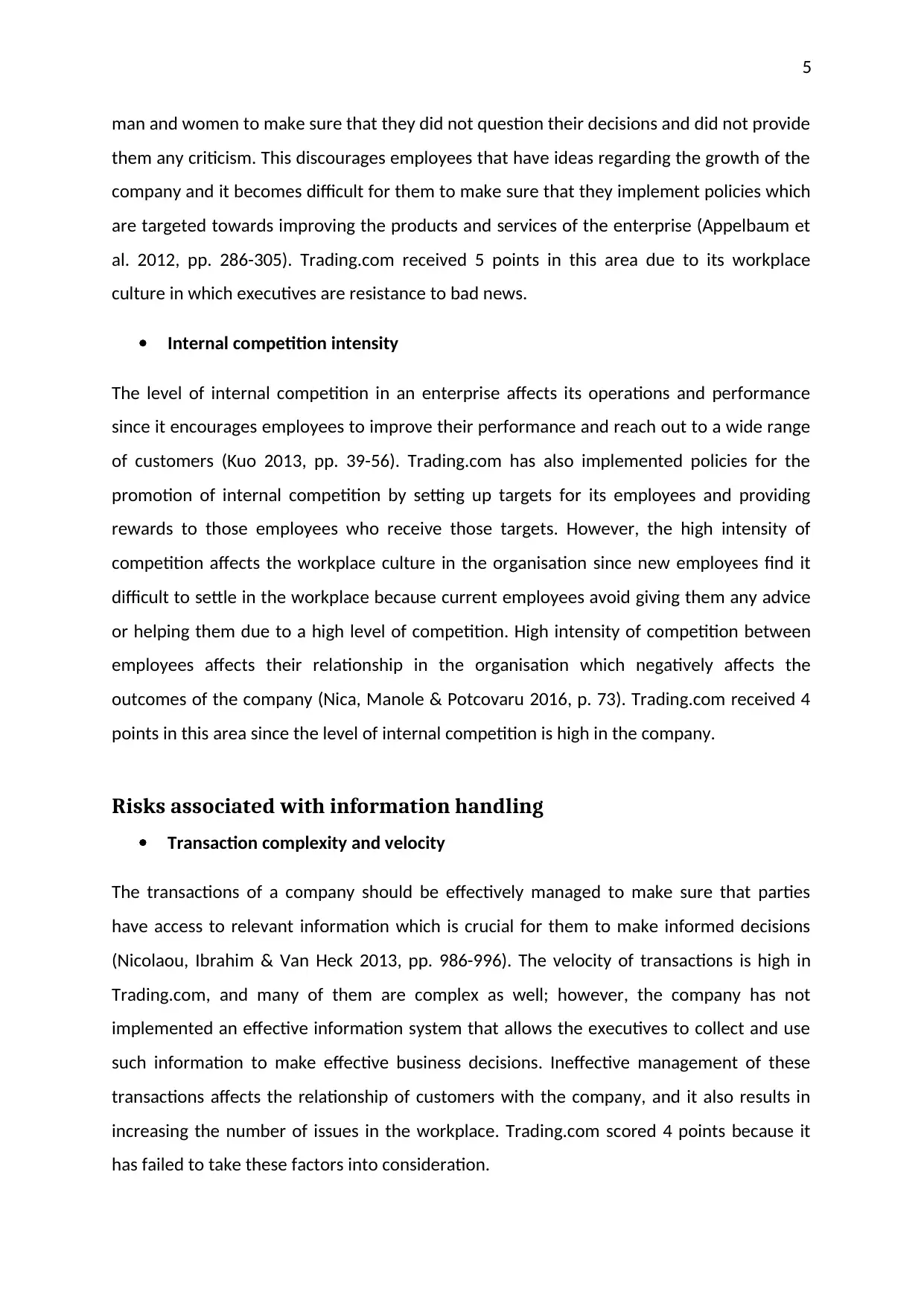
5
man and women to make sure that they did not question their decisions and did not provide
them any criticism. This discourages employees that have ideas regarding the growth of the
company and it becomes difficult for them to make sure that they implement policies which
are targeted towards improving the products and services of the enterprise (Appelbaum et
al. 2012, pp. 286-305). Trading.com received 5 points in this area due to its workplace
culture in which executives are resistance to bad news.
Internal competition intensity
The level of internal competition in an enterprise affects its operations and performance
since it encourages employees to improve their performance and reach out to a wide range
of customers (Kuo 2013, pp. 39-56). Trading.com has also implemented policies for the
promotion of internal competition by setting up targets for its employees and providing
rewards to those employees who receive those targets. However, the high intensity of
competition affects the workplace culture in the organisation since new employees find it
difficult to settle in the workplace because current employees avoid giving them any advice
or helping them due to a high level of competition. High intensity of competition between
employees affects their relationship in the organisation which negatively affects the
outcomes of the company (Nica, Manole & Potcovaru 2016, p. 73). Trading.com received 4
points in this area since the level of internal competition is high in the company.
Risks associated with information handling
Transaction complexity and velocity
The transactions of a company should be effectively managed to make sure that parties
have access to relevant information which is crucial for them to make informed decisions
(Nicolaou, Ibrahim & Van Heck 2013, pp. 986-996). The velocity of transactions is high in
Trading.com, and many of them are complex as well; however, the company has not
implemented an effective information system that allows the executives to collect and use
such information to make effective business decisions. Ineffective management of these
transactions affects the relationship of customers with the company, and it also results in
increasing the number of issues in the workplace. Trading.com scored 4 points because it
has failed to take these factors into consideration.
man and women to make sure that they did not question their decisions and did not provide
them any criticism. This discourages employees that have ideas regarding the growth of the
company and it becomes difficult for them to make sure that they implement policies which
are targeted towards improving the products and services of the enterprise (Appelbaum et
al. 2012, pp. 286-305). Trading.com received 5 points in this area due to its workplace
culture in which executives are resistance to bad news.
Internal competition intensity
The level of internal competition in an enterprise affects its operations and performance
since it encourages employees to improve their performance and reach out to a wide range
of customers (Kuo 2013, pp. 39-56). Trading.com has also implemented policies for the
promotion of internal competition by setting up targets for its employees and providing
rewards to those employees who receive those targets. However, the high intensity of
competition affects the workplace culture in the organisation since new employees find it
difficult to settle in the workplace because current employees avoid giving them any advice
or helping them due to a high level of competition. High intensity of competition between
employees affects their relationship in the organisation which negatively affects the
outcomes of the company (Nica, Manole & Potcovaru 2016, p. 73). Trading.com received 4
points in this area since the level of internal competition is high in the company.
Risks associated with information handling
Transaction complexity and velocity
The transactions of a company should be effectively managed to make sure that parties
have access to relevant information which is crucial for them to make informed decisions
(Nicolaou, Ibrahim & Van Heck 2013, pp. 986-996). The velocity of transactions is high in
Trading.com, and many of them are complex as well; however, the company has not
implemented an effective information system that allows the executives to collect and use
such information to make effective business decisions. Ineffective management of these
transactions affects the relationship of customers with the company, and it also results in
increasing the number of issues in the workplace. Trading.com scored 4 points because it
has failed to take these factors into consideration.
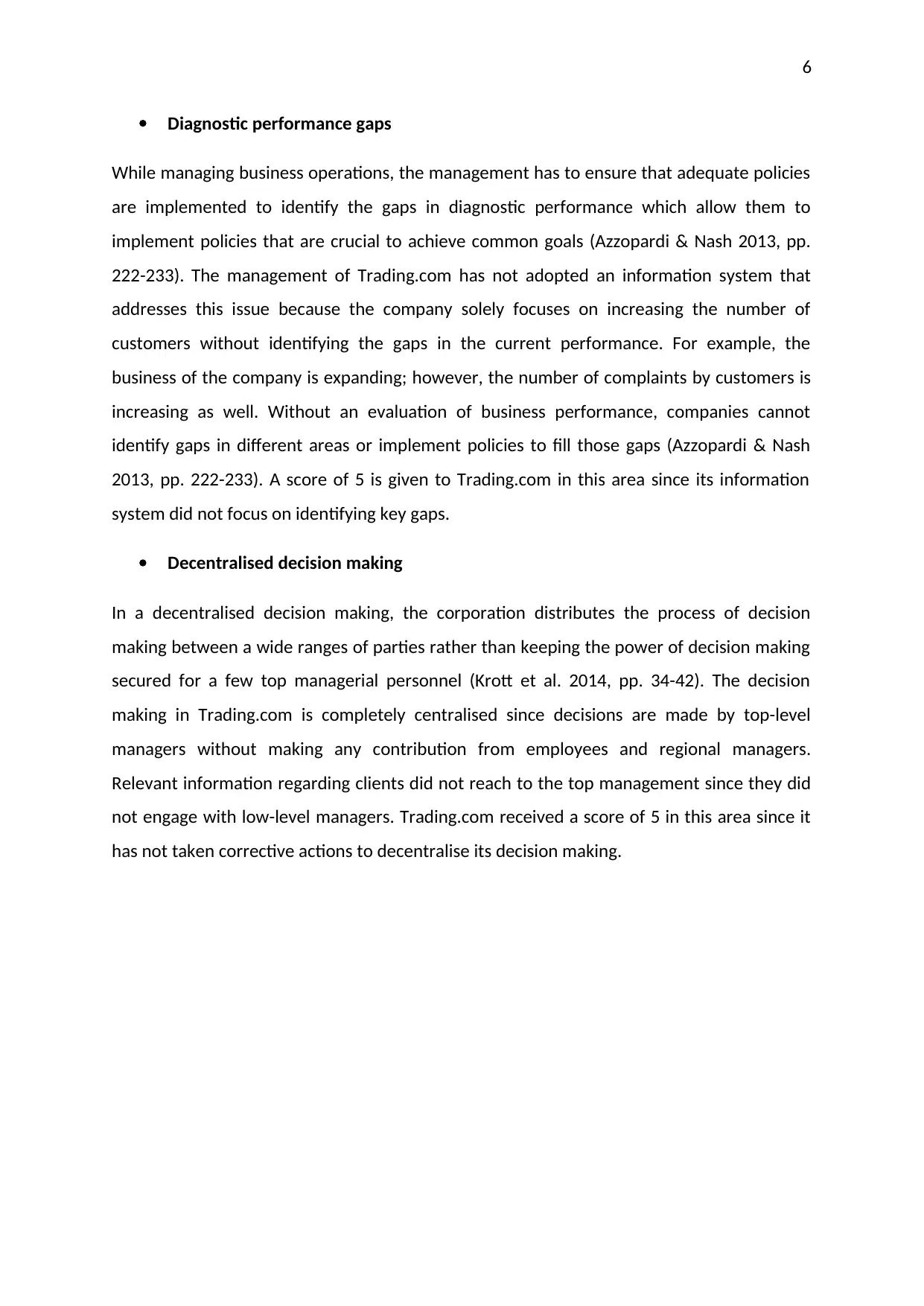
6
Diagnostic performance gaps
While managing business operations, the management has to ensure that adequate policies
are implemented to identify the gaps in diagnostic performance which allow them to
implement policies that are crucial to achieve common goals (Azzopardi & Nash 2013, pp.
222-233). The management of Trading.com has not adopted an information system that
addresses this issue because the company solely focuses on increasing the number of
customers without identifying the gaps in the current performance. For example, the
business of the company is expanding; however, the number of complaints by customers is
increasing as well. Without an evaluation of business performance, companies cannot
identify gaps in different areas or implement policies to fill those gaps (Azzopardi & Nash
2013, pp. 222-233). A score of 5 is given to Trading.com in this area since its information
system did not focus on identifying key gaps.
Decentralised decision making
In a decentralised decision making, the corporation distributes the process of decision
making between a wide ranges of parties rather than keeping the power of decision making
secured for a few top managerial personnel (Krott et al. 2014, pp. 34-42). The decision
making in Trading.com is completely centralised since decisions are made by top-level
managers without making any contribution from employees and regional managers.
Relevant information regarding clients did not reach to the top management since they did
not engage with low-level managers. Trading.com received a score of 5 in this area since it
has not taken corrective actions to decentralise its decision making.
Diagnostic performance gaps
While managing business operations, the management has to ensure that adequate policies
are implemented to identify the gaps in diagnostic performance which allow them to
implement policies that are crucial to achieve common goals (Azzopardi & Nash 2013, pp.
222-233). The management of Trading.com has not adopted an information system that
addresses this issue because the company solely focuses on increasing the number of
customers without identifying the gaps in the current performance. For example, the
business of the company is expanding; however, the number of complaints by customers is
increasing as well. Without an evaluation of business performance, companies cannot
identify gaps in different areas or implement policies to fill those gaps (Azzopardi & Nash
2013, pp. 222-233). A score of 5 is given to Trading.com in this area since its information
system did not focus on identifying key gaps.
Decentralised decision making
In a decentralised decision making, the corporation distributes the process of decision
making between a wide ranges of parties rather than keeping the power of decision making
secured for a few top managerial personnel (Krott et al. 2014, pp. 34-42). The decision
making in Trading.com is completely centralised since decisions are made by top-level
managers without making any contribution from employees and regional managers.
Relevant information regarding clients did not reach to the top management since they did
not engage with low-level managers. Trading.com received a score of 5 in this area since it
has not taken corrective actions to decentralise its decision making.
Paraphrase This Document
Need a fresh take? Get an instant paraphrase of this document with our AI Paraphraser
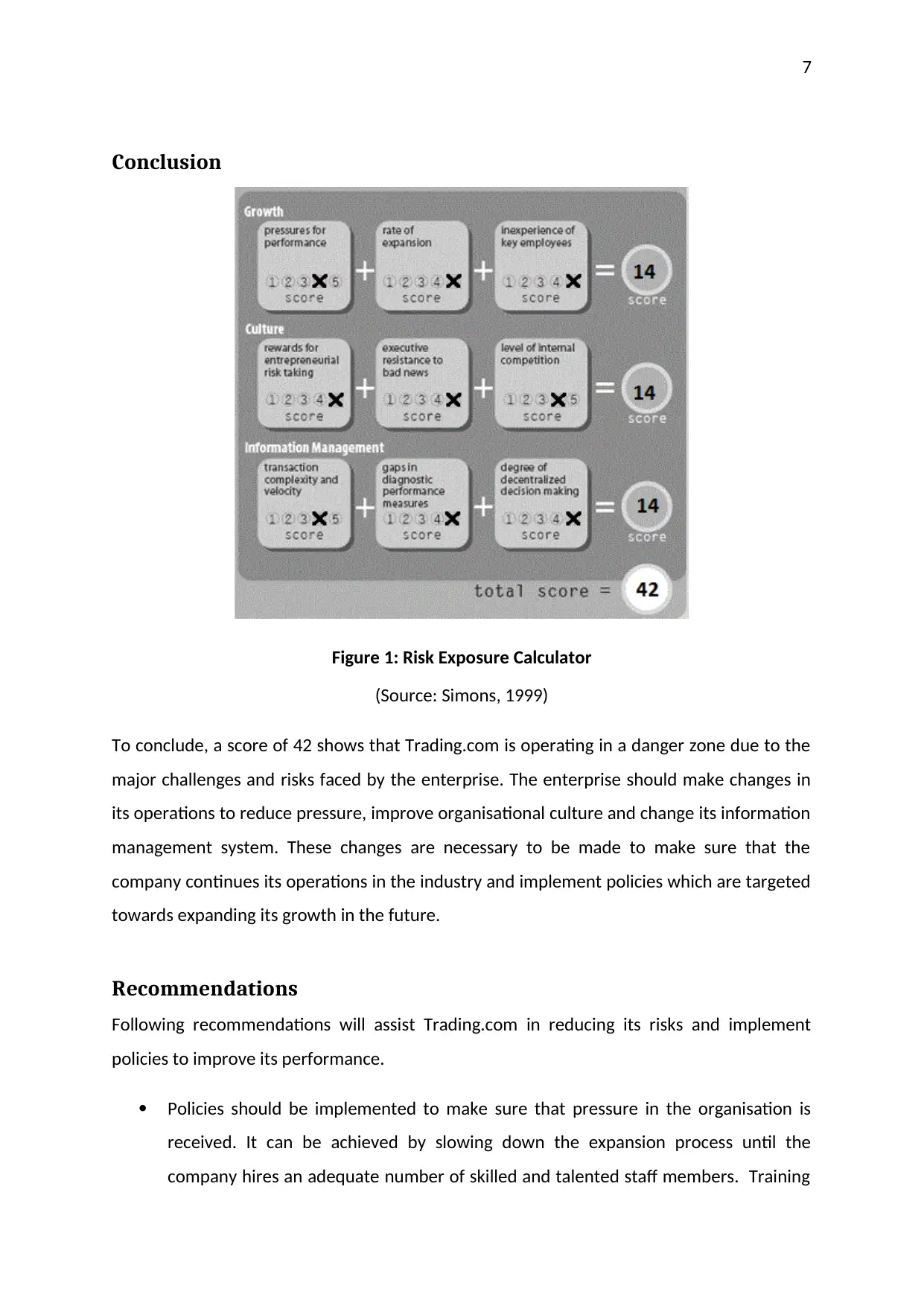
7
Conclusion
Figure 1: Risk Exposure Calculator
(Source: Simons, 1999)
To conclude, a score of 42 shows that Trading.com is operating in a danger zone due to the
major challenges and risks faced by the enterprise. The enterprise should make changes in
its operations to reduce pressure, improve organisational culture and change its information
management system. These changes are necessary to be made to make sure that the
company continues its operations in the industry and implement policies which are targeted
towards expanding its growth in the future.
Recommendations
Following recommendations will assist Trading.com in reducing its risks and implement
policies to improve its performance.
Policies should be implemented to make sure that pressure in the organisation is
received. It can be achieved by slowing down the expansion process until the
company hires an adequate number of skilled and talented staff members. Training
Conclusion
Figure 1: Risk Exposure Calculator
(Source: Simons, 1999)
To conclude, a score of 42 shows that Trading.com is operating in a danger zone due to the
major challenges and risks faced by the enterprise. The enterprise should make changes in
its operations to reduce pressure, improve organisational culture and change its information
management system. These changes are necessary to be made to make sure that the
company continues its operations in the industry and implement policies which are targeted
towards expanding its growth in the future.
Recommendations
Following recommendations will assist Trading.com in reducing its risks and implement
policies to improve its performance.
Policies should be implemented to make sure that pressure in the organisation is
received. It can be achieved by slowing down the expansion process until the
company hires an adequate number of skilled and talented staff members. Training

8
facilities should be provided to the employees to make sure that they are able to
improve their skills and knowledge which will allow them to develop their abilities to
discharge their duties and build a positive relationship with the customers. This will
reduce the pressure, and it will boost the performance of the company by making
sure that its clients receive high-quality services from its employees.
Positive workplace culture should be adopted by the company by implementing
policies to eliminate resistance to bad news and increasing engagement with
employees and consultants. The intensity of internal competition should be reduced,
and policies should be adopted by the company to make sure that new employees
did not face challenges when they start their work in the organisation. They should
receive support from the staff members and the managers which will allow them to
build positive relationships by creating a positive workplace environment.
The enterprise should also implement policies that are focused on changing the
processes of its information system to make sure that crucial information is available
for the management during the decision making the process. This can be achieved by
the implementation of policies that allow the managers to make sure that they
increase engagement with employees to collect relevant information regarding
clients that leads to improving their services. The decision-making process of the
company should be changed as well by the implementation of policies that are
targeted towards delegating the small decision making authority to regional
managers. The employees should also contribute to this process by providing their
feedback regarding current and future policies of the enterprise. It will enable the
organisation to improve its services and creates a positive brand reputation in the
market.
facilities should be provided to the employees to make sure that they are able to
improve their skills and knowledge which will allow them to develop their abilities to
discharge their duties and build a positive relationship with the customers. This will
reduce the pressure, and it will boost the performance of the company by making
sure that its clients receive high-quality services from its employees.
Positive workplace culture should be adopted by the company by implementing
policies to eliminate resistance to bad news and increasing engagement with
employees and consultants. The intensity of internal competition should be reduced,
and policies should be adopted by the company to make sure that new employees
did not face challenges when they start their work in the organisation. They should
receive support from the staff members and the managers which will allow them to
build positive relationships by creating a positive workplace environment.
The enterprise should also implement policies that are focused on changing the
processes of its information system to make sure that crucial information is available
for the management during the decision making the process. This can be achieved by
the implementation of policies that allow the managers to make sure that they
increase engagement with employees to collect relevant information regarding
clients that leads to improving their services. The decision-making process of the
company should be changed as well by the implementation of policies that are
targeted towards delegating the small decision making authority to regional
managers. The employees should also contribute to this process by providing their
feedback regarding current and future policies of the enterprise. It will enable the
organisation to improve its services and creates a positive brand reputation in the
market.
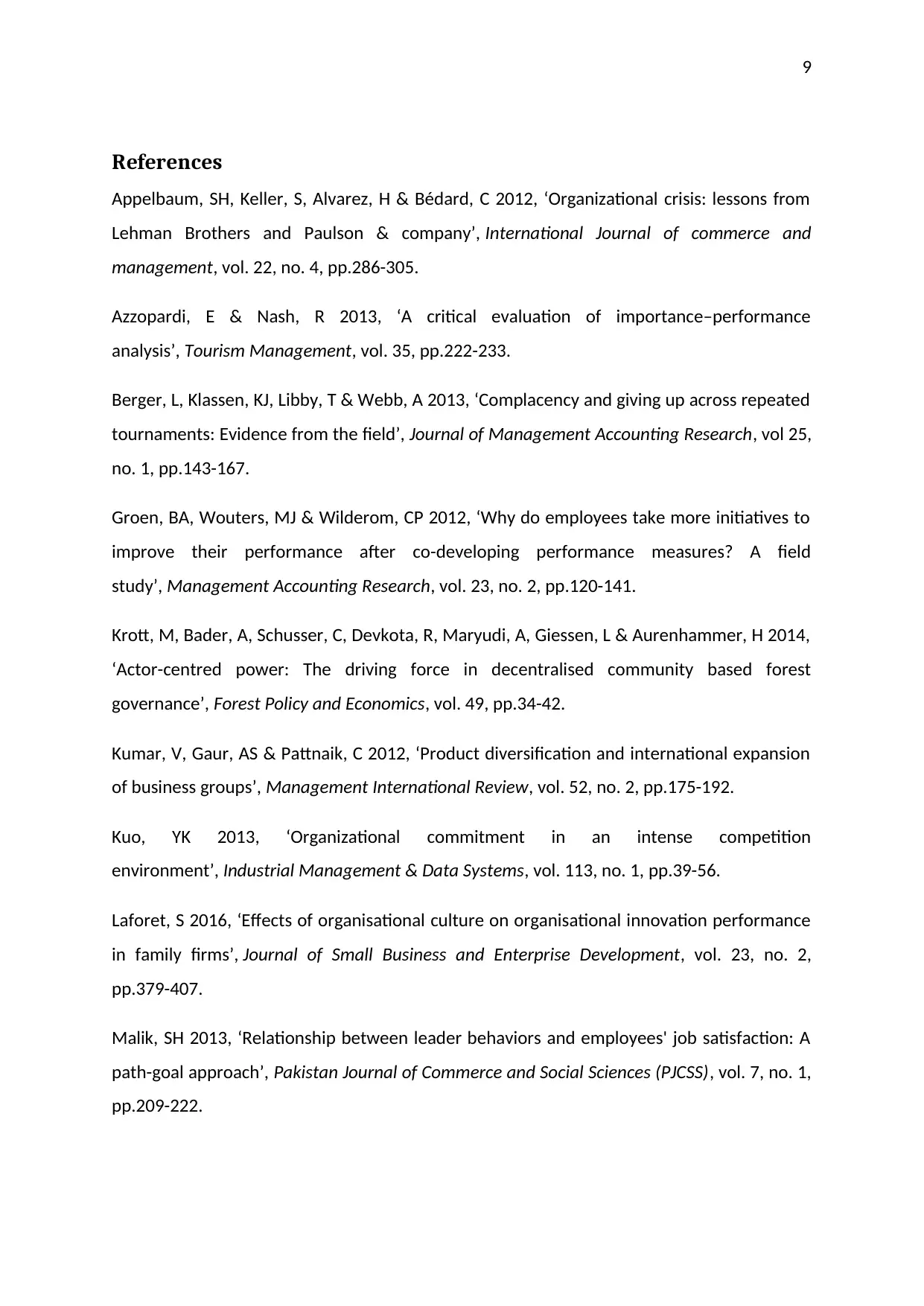
9
References
Appelbaum, SH, Keller, S, Alvarez, H & Bédard, C 2012, ‘Organizational crisis: lessons from
Lehman Brothers and Paulson & company’, International Journal of commerce and
management, vol. 22, no. 4, pp.286-305.
Azzopardi, E & Nash, R 2013, ‘A critical evaluation of importance–performance
analysis’, Tourism Management, vol. 35, pp.222-233.
Berger, L, Klassen, KJ, Libby, T & Webb, A 2013, ‘Complacency and giving up across repeated
tournaments: Evidence from the field’, Journal of Management Accounting Research, vol 25,
no. 1, pp.143-167.
Groen, BA, Wouters, MJ & Wilderom, CP 2012, ‘Why do employees take more initiatives to
improve their performance after co-developing performance measures? A field
study’, Management Accounting Research, vol. 23, no. 2, pp.120-141.
Krott, M, Bader, A, Schusser, C, Devkota, R, Maryudi, A, Giessen, L & Aurenhammer, H 2014,
‘Actor-centred power: The driving force in decentralised community based forest
governance’, Forest Policy and Economics, vol. 49, pp.34-42.
Kumar, V, Gaur, AS & Pattnaik, C 2012, ‘Product diversification and international expansion
of business groups’, Management International Review, vol. 52, no. 2, pp.175-192.
Kuo, YK 2013, ‘Organizational commitment in an intense competition
environment’, Industrial Management & Data Systems, vol. 113, no. 1, pp.39-56.
Laforet, S 2016, ‘Effects of organisational culture on organisational innovation performance
in family firms’, Journal of Small Business and Enterprise Development, vol. 23, no. 2,
pp.379-407.
Malik, SH 2013, ‘Relationship between leader behaviors and employees' job satisfaction: A
path-goal approach’, Pakistan Journal of Commerce and Social Sciences (PJCSS), vol. 7, no. 1,
pp.209-222.
References
Appelbaum, SH, Keller, S, Alvarez, H & Bédard, C 2012, ‘Organizational crisis: lessons from
Lehman Brothers and Paulson & company’, International Journal of commerce and
management, vol. 22, no. 4, pp.286-305.
Azzopardi, E & Nash, R 2013, ‘A critical evaluation of importance–performance
analysis’, Tourism Management, vol. 35, pp.222-233.
Berger, L, Klassen, KJ, Libby, T & Webb, A 2013, ‘Complacency and giving up across repeated
tournaments: Evidence from the field’, Journal of Management Accounting Research, vol 25,
no. 1, pp.143-167.
Groen, BA, Wouters, MJ & Wilderom, CP 2012, ‘Why do employees take more initiatives to
improve their performance after co-developing performance measures? A field
study’, Management Accounting Research, vol. 23, no. 2, pp.120-141.
Krott, M, Bader, A, Schusser, C, Devkota, R, Maryudi, A, Giessen, L & Aurenhammer, H 2014,
‘Actor-centred power: The driving force in decentralised community based forest
governance’, Forest Policy and Economics, vol. 49, pp.34-42.
Kumar, V, Gaur, AS & Pattnaik, C 2012, ‘Product diversification and international expansion
of business groups’, Management International Review, vol. 52, no. 2, pp.175-192.
Kuo, YK 2013, ‘Organizational commitment in an intense competition
environment’, Industrial Management & Data Systems, vol. 113, no. 1, pp.39-56.
Laforet, S 2016, ‘Effects of organisational culture on organisational innovation performance
in family firms’, Journal of Small Business and Enterprise Development, vol. 23, no. 2,
pp.379-407.
Malik, SH 2013, ‘Relationship between leader behaviors and employees' job satisfaction: A
path-goal approach’, Pakistan Journal of Commerce and Social Sciences (PJCSS), vol. 7, no. 1,
pp.209-222.
Secure Best Marks with AI Grader
Need help grading? Try our AI Grader for instant feedback on your assignments.
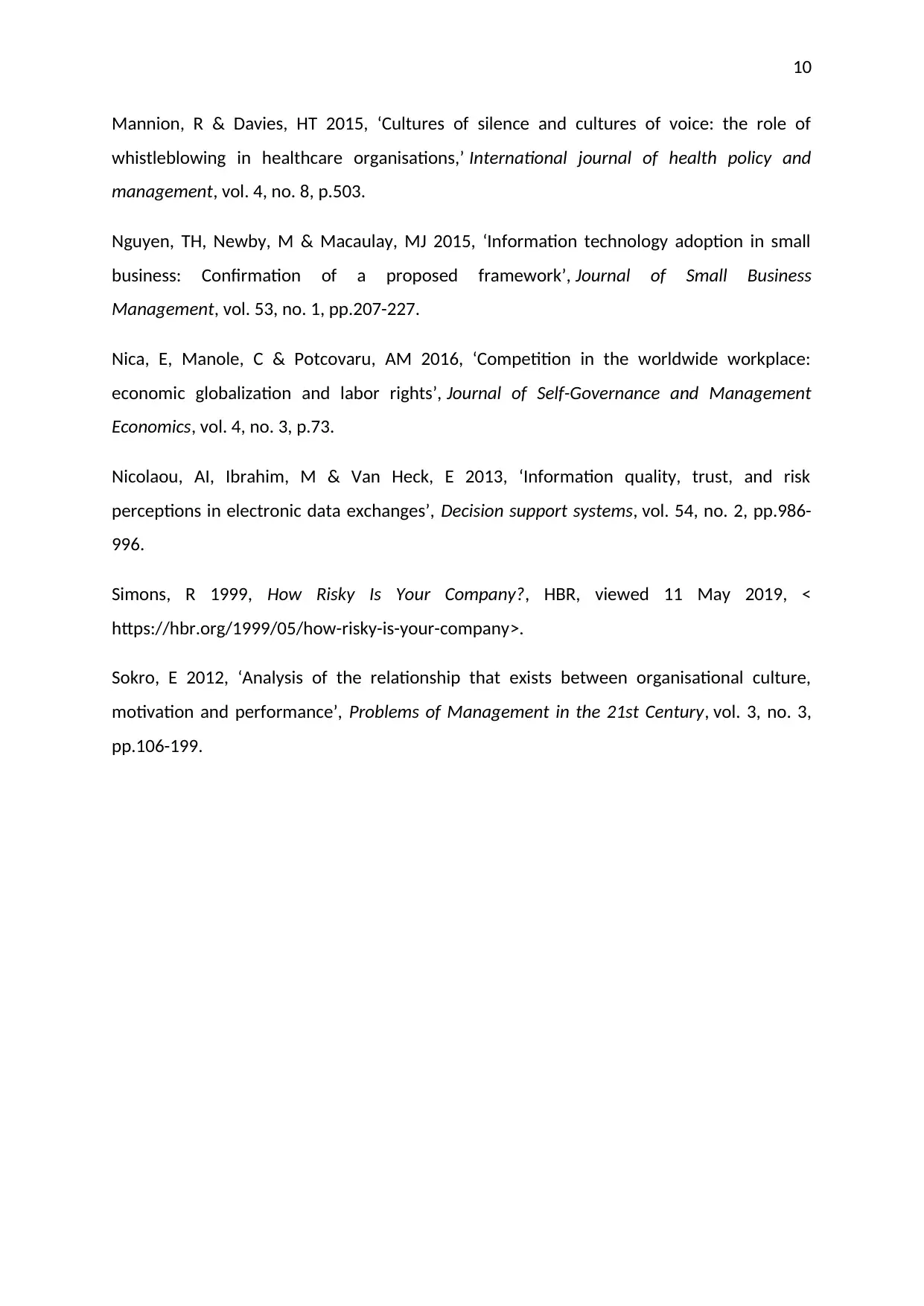
10
Mannion, R & Davies, HT 2015, ‘Cultures of silence and cultures of voice: the role of
whistleblowing in healthcare organisations,’ International journal of health policy and
management, vol. 4, no. 8, p.503.
Nguyen, TH, Newby, M & Macaulay, MJ 2015, ‘Information technology adoption in small
business: Confirmation of a proposed framework’, Journal of Small Business
Management, vol. 53, no. 1, pp.207-227.
Nica, E, Manole, C & Potcovaru, AM 2016, ‘Competition in the worldwide workplace:
economic globalization and labor rights’, Journal of Self-Governance and Management
Economics, vol. 4, no. 3, p.73.
Nicolaou, AI, Ibrahim, M & Van Heck, E 2013, ‘Information quality, trust, and risk
perceptions in electronic data exchanges’, Decision support systems, vol. 54, no. 2, pp.986-
996.
Simons, R 1999, How Risky Is Your Company?, HBR, viewed 11 May 2019, <
https://hbr.org/1999/05/how-risky-is-your-company>.
Sokro, E 2012, ‘Analysis of the relationship that exists between organisational culture,
motivation and performance’, Problems of Management in the 21st Century, vol. 3, no. 3,
pp.106-199.
Mannion, R & Davies, HT 2015, ‘Cultures of silence and cultures of voice: the role of
whistleblowing in healthcare organisations,’ International journal of health policy and
management, vol. 4, no. 8, p.503.
Nguyen, TH, Newby, M & Macaulay, MJ 2015, ‘Information technology adoption in small
business: Confirmation of a proposed framework’, Journal of Small Business
Management, vol. 53, no. 1, pp.207-227.
Nica, E, Manole, C & Potcovaru, AM 2016, ‘Competition in the worldwide workplace:
economic globalization and labor rights’, Journal of Self-Governance and Management
Economics, vol. 4, no. 3, p.73.
Nicolaou, AI, Ibrahim, M & Van Heck, E 2013, ‘Information quality, trust, and risk
perceptions in electronic data exchanges’, Decision support systems, vol. 54, no. 2, pp.986-
996.
Simons, R 1999, How Risky Is Your Company?, HBR, viewed 11 May 2019, <
https://hbr.org/1999/05/how-risky-is-your-company>.
Sokro, E 2012, ‘Analysis of the relationship that exists between organisational culture,
motivation and performance’, Problems of Management in the 21st Century, vol. 3, no. 3,
pp.106-199.
1 out of 11
Related Documents
Your All-in-One AI-Powered Toolkit for Academic Success.
+13062052269
info@desklib.com
Available 24*7 on WhatsApp / Email
![[object Object]](/_next/static/media/star-bottom.7253800d.svg)
Unlock your academic potential
© 2024 | Zucol Services PVT LTD | All rights reserved.





